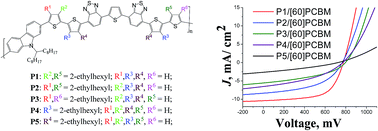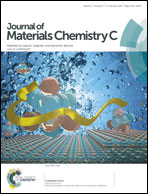A strong influence of the positions of solubilizing alkyl side chains on optoelectronic and photovoltaic properties of TTBTBTT-based conjugated polymers†
Abstract
We report the synthesis and comparative study of five conjugated polymers P1–P5 with different arrangements of two solubilizing 2-ethylhexyl side chains in their repeating units. It has been shown that positioning of the alkyl substituents affects strongly frontier energy levels of the polymers and results in variation of their optical band gaps between 1.65 and 2.0 eV. The highest (2.8 × 10−4 cm2 V−1 s−1) and the lowest (2.4 × 10−5 cm2 V−1 s−1) charge carrier mobilities determined for the polymers P1 and P5, respectively, using a SCLC technique differ by more than one order of magnitude. GIWAXS measurements also revealed very different degrees of molecular ordering in the films of polymers P1–P5 which correlate well with the SCLC mobility data and solid state photoluminescence spectra of these materials. The bulk heterojunction solar cells based on the composites of polymers P1–P5 with [60]PCBM demonstrated power conversion efficiencies ranging from 0.6% (P5) to 5.1% (P1) thus evidencing a strong influence of the alkyl side chains on the photovoltaic performance of the designed polymer-based materials.


 Please wait while we load your content...
Please wait while we load your content...